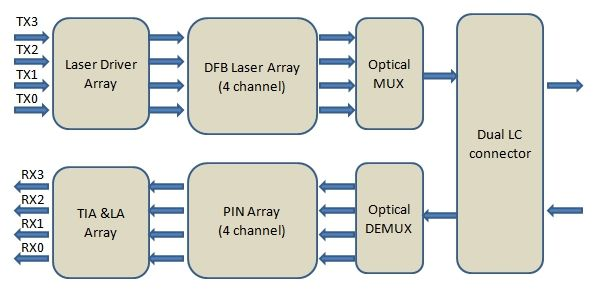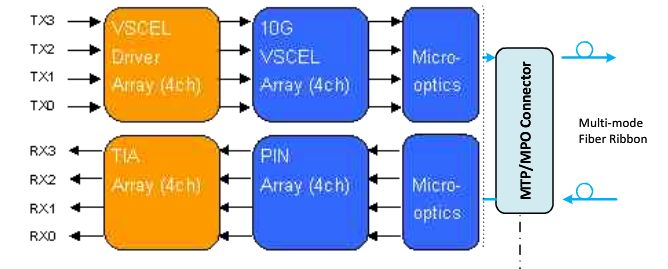The 40G network connection technology solution includes 40G QSFP+ series optical transceiver modules. Among them, the most common ones are 40GBASE-LR4 QSFP+, 40GBASE-SR4 QSFP+, and 40G LR4 PSM. In addition, the high-speed cable DAC-40G QSFP+ and active optical cable AOC-40G QSFP+ have attracted the attention of more and more users in the industry This article will introduce and explain the above technology solutions, and then provide an analytical reference for users to select 40G connection solutions.
QSFP, short for Quad (4-channel) Small Form-factor Pluggable is a compact, hot-swappable transceiver that can also be used for data communication applications. QSFP+ is composed of 4 channels of 10Gb/s rate supporting Infiniband, SFF-8436 standard, Fiber Channel, Ethernet, and another proprietary interconnects. Abbreviated from Quad Small Form Factor Pluggable Plus, QSFP+ is an enhanced version of QSFP. Compared with QSFP, QSFP+ has higher bandwidth of 10Gbp/s Ethernet per channel, thus the data rate of the 4 channels can be combined into 40Gbps/s in compliance with Infiniband, Fiber Channel, Ethernet SAS, and SONET / SDH.
QSFP+ optical ports are in compliance with protocols of 40G Ethernet, IEEE802.3ba-2010, and MSA standard, which specified that either 12-fiber MPO or duplex LC can be the interface to the QSFP optical module family. The former connector is usually applied in modules with multi-mode fiber(MMF), while the latter is applied in those with single-mode fiber(SMF). 40GBASE-SR4 and 40GBASE-LR4 exemplify MPO/MTP and LC interface applications in optical transceivers.
The 40G LR4 QSFP+ optical module is generally connected to the LC connector, and its maximum transmission distance can reach 10km over single-mode fiber. A QSFP 40G LR4 optical module has four independent channels to transmit and receive optical signals, which need to be processed by MUX or DEMUX(an optical component for wavelength division) to multiplex and demultiplex.

∆ Diagram of 40G LR4 QSFP+ optical module’s fundamental
In compliance with the 802.3ba standard, the 40G BASE-LR4 QSFP+ optical module can be used with the LC fiber connector and its transmission rate can reach 40Gbps. This type of optical module has 4 data transmission channels, each of which can transmit data at a speed up to 10.3125Gbps. When the four channels work simultaneously, the network connectivity can realize a combined 40Gbps by using 4 wavelengths on one pair of single-mode optical fiber. 40G QSFP+ LR4 optical transceiver modules are usually applied for data connection between data centers and Internet exchange points with a transmission distance of up to 10km.
40GBASE-SR4 QSFP+ complies with the 802.3ba D3.2 (40GBASE-SR4) standard and can be used with MPO/MTP optical connectors to achieve 40Gbps optical signal connections. Similarly, 40G SR4 QSFP+ modules transmit optical signals over 4 channels with the same transmission data rate as that of the QSFP+ LR4. In data centers, the 40GBASE-SR4 QSFP+ optical module can work with multi-mode OM3/OM4 optical fiber to achieve a transmission distance of 100m (OM3) and 150m (OM4), enabling the interconnection between two Ethernet switches.

∆ Diagram of 40G SR4 QSFP+ optical module’s working
QSFP+ 40G SR4 optical modules are often connected with MPO/MTP interfaces in 40G data transmission. Different from the QSFP+ 40G LR4 optical module, this 40G SR4 optical transceiver transmits the signal over multi-mode fiber breakout cables, two types of which are OM3 and OM4 with a max transmission distance of 100m and 150m respectively. When the signal is at the transmitting end, the laser array first converts the electrical signal into an optical signal and sends it in parallel through the ribbon multimode fiber. At the receiver end, the photodetector array converts the parallel optical signal into a parallel electrical signal. The following diagram illustrates the signal transmission in a QSFP+ 40G SR4 optical transceiver.
The 40G LR4 PSM optical module is designed with optical/electrical connection and digital diagnostic interface according to the QSFP+ multi-source protocol. As a highly integrated 4-channel optical module, 40G QSFP LR4 PSM has a higher port density and is more cost-effective for the entire system’s operation. This optical module adopts the parallel single-mode technology PSM (Parallel Single-Mode), and the 4-way parallel-designed MPO/MTP interface can realize a stable and efficient transmission of 10km.
40G LR4 PSM and 40G SR4 QSFP+ transceiver work in the same way, i.e. the electrical signal is transferred to optical signal through the laser array, and then the optical signal is converted into an electrical signal by the photodetector array. However, 40G QSFP+ LR4 PSM optical modules connect with single-mode fiber connectors, dedicating that parallel optical signals are sent in parallel through 8 single-mode fibers.
In summary, QSFP+ 40G SR4 optical modules are suitable for short-distance transmission in data centers to connect Ethernet switches with OM3/OM4 ribbon fiber cables. The 40G LR4 QSFP+ and 40G LR4 PSM optical module are network connectivity solutions for long-distance transmission instead. But the 40G LR4 QSFP+ is more cost-effective in that there are only two single-mode fibers while the 40G LR4 PSM optical module requires eight single-mode fibers.
Next: Telecom sector will shine in post Covid-19 era, says GlobalData